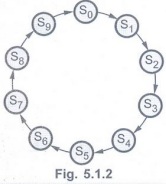Digital Principles and Computer Organization: Unit II (d): Counters
Introduction of Counters
Counters - Digital Principles and Computer Organization
A counter is a register capable of counting the number of clock pulses arriving at its clock input. Count represents the number of clock pulses arrived.
Chapter 5: Counters
Introduction of Counters
AU:
Dec.-08
• A counter is a register capable of
counting the number of clock pulses arriving at its clock input.
• Count represents the number of clock
pulses arrived.
• On arrival of each clock pulse, the
counter is incremented by one.
• In case of down counter, on arrival of
each clock pulse, it is decremented by one.
• The Fig. 5.1.1 shows the logic symbol
of a binary counter.

• External clock is applied to the clock
input of the counter.
• The counter can be positive edge
triggered or negative edge triggered.
• The n-bit binary counter has n
flip-flops and it has 2n distinct states of outputs.
• For example, 2-bit counter has 2
flip-flops and it has 4 (22) distinct states: 00, 01,10 and 11.
• The 3-bit binary counter has 3
flip-flops and it has 8 (23) distinct states: 000, 001, 010, 011,
100, 101 110 and 111.
• The maximum count that the binary
counter can count is 2n-1.
• For example, in 2-bit binary counter,
the maximum count is 22-1-3 (11 in binary).
• After reaching the maximum count the
counter resets to 0 on arrival of the next clock pulse and it starts counting
again.
Synchronous Counter:
• When counter is clocked such that each
flip-flop in the counter is triggered at the same time, the counter is called
synchronous counter.
Asynchronous Counter / Ripple Counter:
• A binary asynchronous/ripple counter
consists of a series connection of complementing flip-flops, with the output of
each flip-flop connected to the clock input of the next higher-order flip-flop.
• The flip-flop holding the least
significant bit receives the incoming clock pulses.
• The Table 5.1.1 shows the comparison
between synchronous and asynchronous
counters.

Modulus of counter
• The total number of counts or stable
states a counter can indicate is called 'Modulus'.
• The modulus of a four-stage counter
would be 1610, since it is capable of indicating 00002 to
11112.
• The term 'modulo' is used to describe
the count capability of counters.
• For example, mod 6 counter goes
through states 0 to 5 and mod 4 counter goes through states 0 - 3.
Example 5.1.1
Draw the state diagram of MOD-10 counter. AU: Dec.-08, Marks 2
Solution :

Example 5.1.2
Assume that the 5-bit binary counter starts in the 00000 state. What will bethe
count after 144 input pulses ?
Solution:(144)10
= (1001 0000)2
Since counter is a 5-bit counter, it
resets after 25 = 32 clock pulses.

Therefore, counter resets four times and
then it counts remaining 16 clock pulses. Thus, the count will be (10000)2,
i.e., 16 in decimal.
In general,

where n = Number of counter bits
Review Questions
1. What is counter?
2. State types of counters.
3. Compare synchronous and asynchronous
counter.
4. What is MOD counter?
5. Give comparison between synchronous
and asynchronous counters.
Digital Principles and Computer Organization: Unit II (d): Counters : Tag: : Counters - Digital Principles and Computer Organization - Introduction of Counters
Related Topics
Related Subjects
Digital Principles and Computer Organization
CS3351 3rd Semester CSE Dept | 2021 Regulation | 3rd Semester CSE Dept 2021 Regulation
